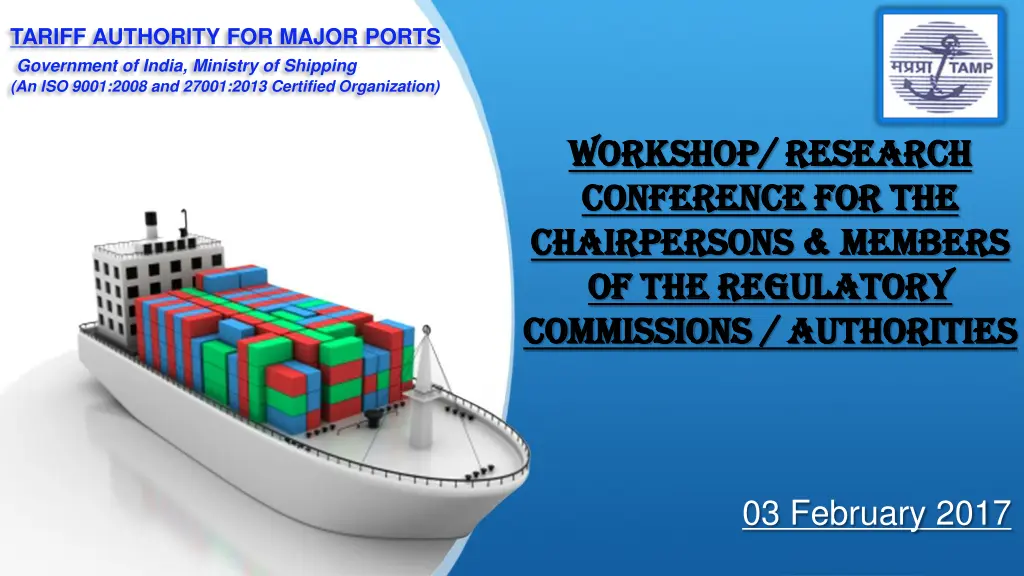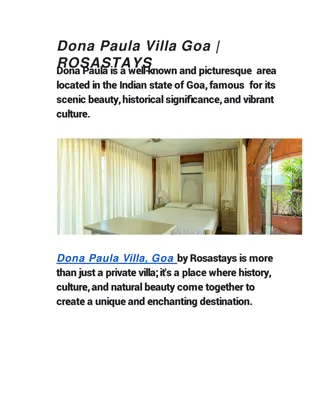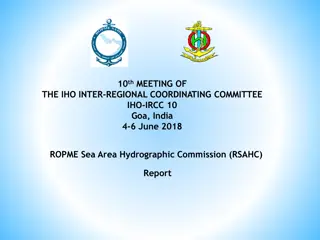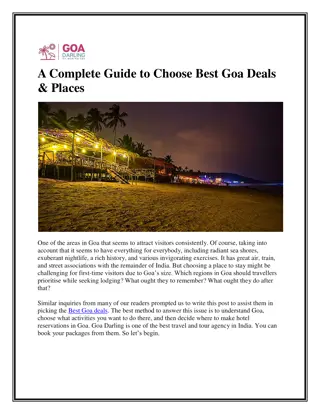
Tariff Authority for Major Ports in India: Regulations and Guidelines
Explore the functions and role of the Tariff Authority for Major Ports (TAMP) in India, an autonomous body regulating tariffs for port services. Learn about its constitution, status, charter, transaction procedures, and tariff guidelines issued by the Ministry of Shipping.
Uploaded on | 0 Views
Download Presentation

Please find below an Image/Link to download the presentation.
The content on the website is provided AS IS for your information and personal use only. It may not be sold, licensed, or shared on other websites without obtaining consent from the author. If you encounter any issues during the download, it is possible that the publisher has removed the file from their server.
You are allowed to download the files provided on this website for personal or commercial use, subject to the condition that they are used lawfully. All files are the property of their respective owners.
The content on the website is provided AS IS for your information and personal use only. It may not be sold, licensed, or shared on other websites without obtaining consent from the author.
E N D
Presentation Transcript
TARIFF AUTHORITY FOR MAJOR PORTS Government of India, Ministry of Shipping (An ISO 9001:2008 and 27001:2013 Certified Organization) WORKSHOP/ RESEARCH WORKSHOP/ RESEARCH CONFERENCE FOR THE CONFERENCE FOR THE CHAIRPERSONS & MEMBERS CHAIRPERSONS & MEMBERS OF OF THE REGULATORY THE REGULATORY COMMISSIONs COMMISSIONs / AUTHORITIES / AUTHORITIES 03 February 2017
Constitution of TAMP Guidelines announced by Government in October 1996. for private participation in port sector TAMP was constituted in April 1997 by an amendment to Major Port Trusts Act, 1963. TAMP comprises of a Chairperson and two Members appointed by Central Government under the Major Port Trusts Act, 1963. 2
Status TAMP is a statutory Autonomous Body. ISO 9001 : 2008 certified organization for Quality Management System (QMS). ISO 27001: 2013 certified organization for Information Security Management System. 3
Charter of the Authority Regulation of tariffs levied by Major Port Trusts and Private Terminals therein. Fix rates for services rendered as well as the charges for use of properties. It is mandated not only to fix the rates but also the conditionalities governing application of the rates. TAMP has passed nearly 900 Tariff orders, since its constitution in April 1997. 4
Transaction of Business Proposals are registered as tariff cases . Consultation with users / user associations / prospective bidders / BOT operators. Joint hearings at port level to hear arguments of different interests on all tariff proposals. All decisions are taken by the collective application of mind by the Authority in its meetings. 5
Tariff Guidelines (GL) TAMP administers following GL issued by Ministry of Shipping (MOS) as policy directions. 2005 GL 2008 GL Applicable for BOT operators. 2013 GL (Applicable for both PPP Projects and Port owned Projects). 2015 GL (For Major Port Trusts) Stevedoring and Shore handling Guidelines, 2016 (For Major Port Trusts) Lease Rent for Port land and properties is fixed following Land Policy Guidelines issued by the MOS from time to time. 6
2005 GL 15 BOT operators Cost Plus Model (16% Return on Capital Employed) Capital addition recognized Operating cost recovered Revision of tariff once in 3 years 7
2008 GL (From February 2008) Tariff fixed for concession period of 30 years. Tariff set on norms not on actual cost. Capacity and not traffic forecast is relevant Tariff set for 70% capacity. Benefit of 30% available to operator. Tariff is known to bidders before they bid. Gradual escalation of tariff (based on 60% of WPI). Simple & fast Built in arrangement to reward efficiency. Operator reaps benefit of cost reduction. User is protected by price ceiling fixed. 8
2013 GL (From July 2013) Applied to set Reference Tariff for Projects at Major Ports (both PPP & Port Projects). Ports can adopt tariff fixed in their own port or can adopt highest tariff fixed in any other Major Port for comparable facilities. If suitable reference tariff not available, port can propose tariff adopting principles of 2008 guidelines. Gradual increase of tariff (based on 60% of WPI). 15% hike in tariff for meeting Performance Standards. Reference tariff is mostly comparable to market rates. 9
Merits of 2013 Guidelines Quick processing of proposals Maximum 45 days. Realistic Project Proposals and very reasonable Tariff Rates. Consultation with Prospective finalization of proposals and fixation of Tariff. Reduction in Time for Award of Projects by Ports. Faster execution of Projects. Attracting Investment both domestic and foreign. Incentive for Better Performance. Grievance Redressal Mechanism Mandatory disclosure by operators. Bidders and Users before 10
Tariff Policy, 2015 for Major Port Trusts (From 13 January 2015) Applicable to all the 11 Major Port Trusts w.e.f.13.01.2015. Not applicable to BOT / BOOT operators. TAMP issued Working Guidelines after consulting all MPTs as per clause 1.5 of the TP 2015. Tariff fixation follows Annual Revenue Requirement (ARR) Model. ARR = Actual Expenditure + 16% Return on Capital Employed Actual Expenditure = Average of last 3 years audited Expenditure subject to some adjustments. Capital employed includes capital work-in-progress. 11
Flexibility to the Major Ports to determine the rates within the ceiling ARR to respond to the market forces based on their commercial judgement. MPTs to also commit Performance Standards for cargo related and vessel related services. Annual Indexation in SOR to the extent of 100% of the WPI, subject to achievement of Performance Standards committed by MPTs. Tariff Valid for three years. 12
Grievance Redressal User may prefer representation to TAMP if he has grievance on non-achievement of performance by Major Ports. TAMP to conduct an inquiry into the representation and forward its findings to the concerned Major Ports with a direction to comply with the Performance Standards notified by the TAMP. Mandatory Disclosure All Major Ports to furnish to TAMP, within 60 days following the end of each of the year, annual reports on cargo traffic and productivity achieved. Tariff for 10 Major Ports Notified. consultation. For 11thPort under 13
Merits of Tariff Policy, 2015 Flexibility of Major Ports to respond to the market forces and determine their own tariff within the ceiling ARR. Less voluminous proposal. Hence processing is quick. Indexation in tariff achievement. Motivation to achieve performance parameters. linked to performance 14
Stevedoring and Shore handling Guidelines Applicable for Agencies or Firms authorized by Major Ports under Section 42(3) of the MPT Act. Tariff to be set upfront based on norms along with Performance Standards. Upfront tariff will be ceiling level. Uniform applicability of Normative upfront tariff at the entire port. Tariff cap valid for 3 years. Annual indexation of Tariff caps from 2ndyear of operation- 60% of variation in WPI. 100% WPI indexation instead of 60% WPI indexation, on achievement of performance standards. 15
Land Policy Guidelines (LPG), 2014 Land Allotment Committee (LAC) to be appointed by Port Trusts to assess the latest market value of Land. Latest market value of land to be assessed based on five factors listed in the LPG, 2014. Highest of the five factors determining the market value of land. If highest factor not considered, reason for the same to be recorded in writing. Lease rent arrived at 6% of the market value of land. Annual escalation not less than 2% in lease rent. SOR to be revised every 5 years. to be considered for 16
The Major Port Authorities Bill, 2016 Introduced in Lok Sabha in December 2016. For regulation, operation and planning of Major Ports. Seeks to provide greater autonomy and flexibility to Major Ports. Board or Committees appointed by Board will determine their tariff. Board to fix tariff for PPP Projects only for initial bidding process; concessionaire is free to fix actual tariff based on market condition. Board can raise loans. For loans above 50% of its capital reserves, prior sanction of Central Govt. 17
Adjudicatory Board Presiding officer and two Members. Presiding officer (Judge of a High Court) Members (Experts in finance, commerce, marine, shipping and port related matters). Head office will be in Mumbai. Shall have the same powers as that of a CIVIL court under the code of Civil Procedure, 1908. Proceeding before the Adjudicatory Board shall be deemed to be judicial proceeding. 18
Functions of Adjudicatory Board Functions of TAMP arising from 2005 GL, 2008 GL and 2013 GL and tariff orders issued by TAMP. Adjudicate dispute or differences or claims related to rights and obligations of Major Ports & PPP concessionaire or captive users for dedicated berths within the frame work of concession Agreement. Appraise, review stressed PPP Projects referred by Central Government / Major Ports and suggest measures to revive such projects. Look into complaints received from port users against the services rendered by Major ports / private operators. Parties not satisfied with the order of the Adjudicatory Board free to resort to arbitration or any other available legal remedy. 19
THANK THANK YOU YOU 20






















